10-Step Guide to Paneer Makhani
Paneer makhani might be tracked down in the northern and heartland areas of India, where the cooking is known for its intense flavors and thick, velvety sauces. While the exact origin story is somewhat elusive, the dish is believed to have emerged in the mid-20th century, attracting the attention of chefs and home cooks.With its increasing appeal, paneer makhani quickly established itself as a standard dish in Indian eateries throughout the country.

A prime example of bliss and taste in the vast and varied world of Indian cuisine is paneer makhanji. Often referred to as Spread Paneer or Paneer Margarine Masala, this dish has gained international recognition as a staple meal. Paneer Makhani exemplifies North Indian cooking with its rich, smooth surface and mix of sweet-smelling flavors, tempting foodies on a connoisseur journey that respects the association of effortlessness and extravagance.
The Art of Making Paneer Makhani:
1. Preparing Paneer:
- Paneer, or Indian cottage cheese, is the star of this dish. Making cheese at home ensures freshness, but store-bought options work just as well. Ready to absorb the rich flavor of the curry, cut it into bite-sized cubes.
2. Making Makhani Gravy:
- Makhani gravy is the soul of the dish. The combination of tomatoes, cashews, and cream creates a velvety texture. Cook this mixture on low heat so that the flavors meld, resulting in a luxurious base for the paneer.
3. Symphony of Spices:
- Garam masala, cumin, coriander, and a touch of kasuri methi (dried fenugreek leaves) contribute to the distinctive flavor profile. A careful balance of these spices is important to achieve the perfect harmony that defines Paneer Makhani.
4. Role of Tomatoes:
- Tomatoes play a dual role, adding both acidity and sweetness. A tip for enhanced flavor is to use ripe tomatoes or to intensify their natural sweetness by roasting them before blending.
5. Butter Element:
- As the name suggests, butter is the main ingredient. While it contributes to the richness of the dish, moderation is key. Balancing the buttery goodness ensures a beautiful texture without overwhelming the palate.
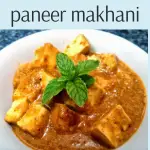
Paneer Makhani
Ingredients
For the Paneer&Makhani Gravy
- 500g paneer (Indian cottage cheese), cut into cubes
- 6 large tomatoes, ripe and chopped
- ½ cup cashews, soaked in warm water
- 1 cup heavy cream
- ¼ cup butter
- 1 large onion, finely chopped
- 4 cloves garlic, minced
- 1-inch ginger, grated
- 2 green chilies, finely chopped
- 1 teaspoon cumin seeds
- 1 teaspoon red chili powder
- 1 teaspoon garam masala
- 1 teaspoon turmeric powder
- 1 teaspoon coriander powder
- 1 teaspoon kasuri methi (dried fenugreek leaves)
- Salt to taste
- Fresh coriander leaves for garnish
Optional
- 1 tablespoon honey or sugar (to balance acidity)
- ½ teaspoon cardamom powder (for a fragrant touch)
Instructions:
Prepare Makhani Gravy:
- Combine chopped tomatoes and soaked cashews in a blender. Blend until smooth.
- Melt butter in a pan and add cumin seeds. Once they splutter, add chopped onion, minced garlic, and grated ginger. Fry until golden brown.
- Add chopped green chilies and tomato-cashew puree. Cook on medium heat until the mixture thickens and the oil starts to separate.
- Add the salt, garam masala, turmeric, coriander, and red chili powder. Stir thoroughly and heat for a short while.
Cook the cheese.
- In a separate pan, gently fry the paneer cubes until golden brown. Set aside.
Combine the cheese and gravy:
- Add the fried paneer cubes to the makhani gravy. Simmer for 10–15 minutes, allowing the flavors to meld.
- Crush the kasoori methi between your palms and sprinkle it over the curry. Optionally, add honey or sugar for sweetness and cardamom powder for aroma.
Finish with cream and garnish.
- Pour in the heavy cream and stir gently. Let it boil for an additional 5 minutes.
- Garnish with fresh coriander.
Serve hot:
- Paneer Makhani can be enjoyed hot. Serve it with naan, roti, or steamed basmati rice.

Perfecting Paneer Makhani requires a balance of flavors and textures. Here are some tips to help you achieve the best results:
- Use fresh, high-quality cheese for the best taste and texture. You can buy it from a trusted source or make it at home for an authentic touch.
Balanced the creaminess of the dish by adjusting the amount of cream and butter. While these ingredients contribute richness, moderation is key to avoiding overwhelming the palate. - Saute the onion until golden brown to add sweet depth to the gravy.Layers of flavors, from caramelized onions to the richness of tomatoes and cream, are necessary to achieve a superb taste.
- Add the paneer cubes towards the end of the cooking process. This prevents them from becoming too soft or losing their distinct texture
- Serve Paneer Makhani hot with naan, roti, or steamed basmati rice. The eating experience can be greatly improved by selecting the right accompaniments.
- Paneer Makhani stores well in the refrigerator, but reheating may change its texture. If possible, reheat on low heat to maintain creaminess.
- Feel free to personalize the dish based on your preferences. Some like it spicy, while others prefer it mild. Paneer Makhani is versatile and can be adjusted to suit your taste.
Key Nutrients:
- Protein: Paneer (cottage cheese) is a good source of protein, which provides essential amino acids for muscle repair and growth.
- Fat: The richness of Paneer Makhani comes from cream and butter.It raises the overall fat level in addition to adding flavor.
- Carbohydrates, mainly from tomatoes and other vegetables, contribute to the energy content.
- Fiber: The dish may contain some dietary fiber, especially if you include ingredients like onions and tomatoes.
- Cholesterol: Cheese contains dietary cholesterol, and the use of cream and butter contributes to the overall cholesterol content.
- Sodium: Sodium content can vary depending on the amount of salt and sodium-containing ingredients used in the recipe.
Note:
- Actual nutritional values may vary based on specific ingredients, portion sizes, and cooking methods.
- The aforementioned figures are approximations and ought to serve as a broad reference.
Conclusion:
A feast that epitomizes tradition and sinful pleasure, paneer makahani is a magnificent pearl in the exquisite needlework of Indian culinary destiny. Its excursion from North Indian food to plates all over the planet exhibits how fragrances that convey comfort and delight are widespread. As you savor the creamy symphony of Paneer Makhani, you partake in a culinary experience that goes beyond taste—it’s the sheer joy of enjoying an iconic dish that has stood the test of history, culture, and time.
FAQ
1. What is the difference between Paneer Makhani and Shahi Paneer?
In short, the main difference between Paneer Makhani and Shahi Paneer lies in their respective gravies and flavor profiles:
Paneer Makhani:
- Gravy Base: Paneer Makhani has a tomato-based gravy enriched with cashews and cream, resulting in a rich and creamy texture.
- Flavor Profile: It has a balanced blend of spices, with dominant tomato and cream flavors, creating a mildly sweet and tangy flavor.
Shahi Paneer:
- Gravy base: Shahi Paneer, which means “royal cheese,” consists of a gravy that includes cashews, almonds, and sometimes poppy or watermelon seeds.
- Flavor Profile: Rich and aromatic flavors are emphasized, with a more nutty and creamy color, often containing saffron and other royal spices.
- While both dishes showcase the versatility of Paneer (Indian cottage cheese), Paneer Makhani is known for its tomato-creamy richness, while Shahi Paneer lends the dish a sumptuous status with its nutty and elegant flavor profile.
2. What is paneer makhani?
- Paneer Makhani is a classic North Indian dish featuring cubes of paneer (Indian cottage cheese) in a rich and creamy tomato-based gravy.It is a delectable vegetarian dish that is generally eaten with Indian roti or rice.
3. For how many days does paneer not spoil?
- Homemade cheese: If you make cheese at home, it is usually best eaten within 2 to 3 days when stored in the refrigerator. Homemade cheese usually does not contain preservatives, so it spoils more quickly than store-bought varieties.
- Store-Bought Cheese: Commercially produced cheese often comes with a longer shelf life, especially if it is packaged in vacuum-sealed or airtight packaging. Generally, it can last anywhere from 1 to 2 weeks in the refrigerator, depending on the specific packaging and preservatives used.

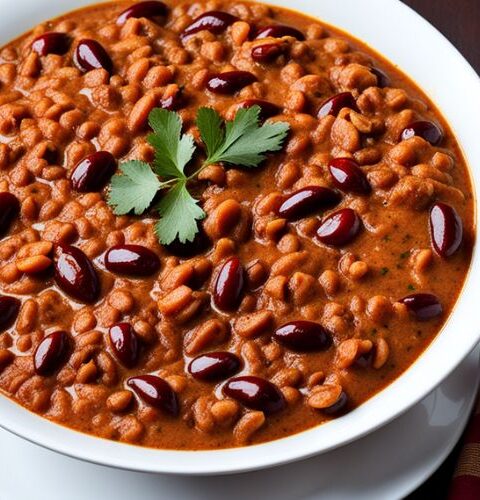
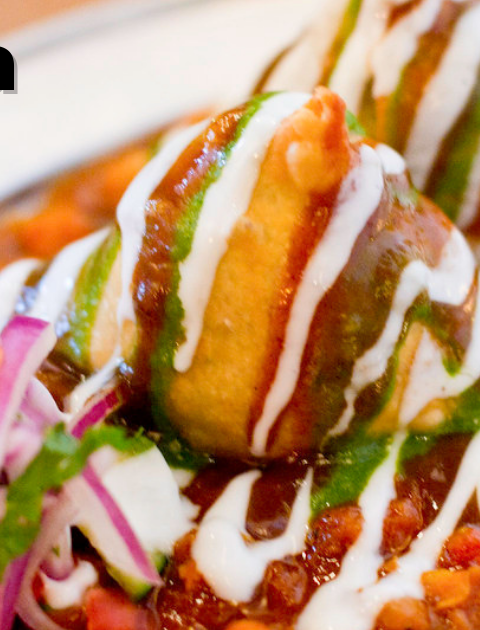

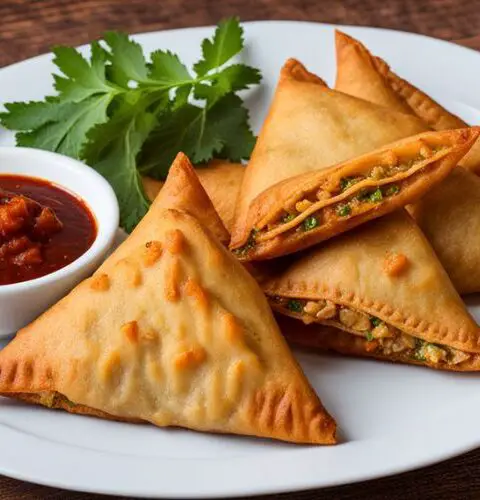

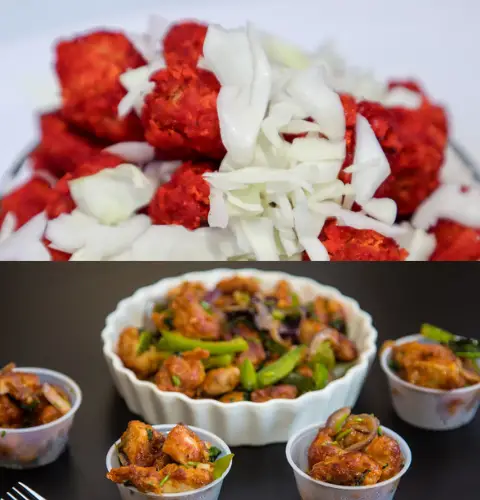
[…] Section 2: Step-by-step process […]